Learn Adobe Premiere Pro in 2023
by Arthur Yang October 23, 2023

Video editing is crucial in the digital age as it enables effective storytelling, enhances communication, and drives engagement, making it essential for creatives to convey their messages effectively.
However, picking up Adobe Premiere Pro may be daunting to those who have no editing experience.
In our guide ‘Learn Adobe Premiere Pro in 2023,’ we will break down all the information you need to know about Premiere Pro in 2023.
Here’s a glimpse of what we’ll explore:
1. Is Adobe Premiere Pro easy to learn?
2. What is Adobe Creative Cloud?
3. Adobe Premiere Pro’s System Requirements
4. New Features on Adobe Premiere Pro 2023
5. Adobe Premiere Pro Tutorials
6. Alternatives to Adobe Premiere Pro
7. Conclusion
Let’s go!
Learn Adobe Premiere Pro in 2023
Is Adobe Premiere Pro easy to learn?
#1 — It is worth learning despite the challenge
The ease of learning Adobe Premiere Pro can vary greatly depending on your background, previous experience with video editing software, and the level of complexity of the projects you want to undertake.
Adobe Premiere Pro offers a wide array of powerful features, including advanced video and audio editing, colour grading, special effects, and more.
For beginners, Adobe Premiere Pro can initially seem overwhelming due to its extensive range of features and tools.
However, Adobe has designed the software with user-friendliness in mind, providing intuitive interfaces and a wealth of online resources such as tutorials, forums, and guides.
With patience and consistent practice, beginners can grasp the basics relatively quickly.
If you’re entirely new to video editing, there will be a learning curve as you familiarise yourself with the interface, terminology, and various editing techniques.
Alternatively, there is a wide range of tutorials and step by step guides on YouTube that you can watch and learn from.
However, if you have prior experience with video editing software, especially non-linear editing systems, you may find it easier to adapt to Premiere Pro.
Regardless of background, more practice and hands-on experience are key to mastering any professional video editing software.
#2 — How long does it take to learn Adobe Premiere Pro?
Learning fundamental skills in Premiere Pro requires approximately 12 hours, while mastering advanced video editing demands an additional 12 hours.
However, the learning duration may differ based on prior editing expertise.
#3 — Where can I download Adobe Premiere Pro?
You can download Adobe Premiere Pro from their official website here.
Keep in mind that it is a subscription-based service.
Look out for their cost pricing for different users below.
What is Adobe Creative Cloud?
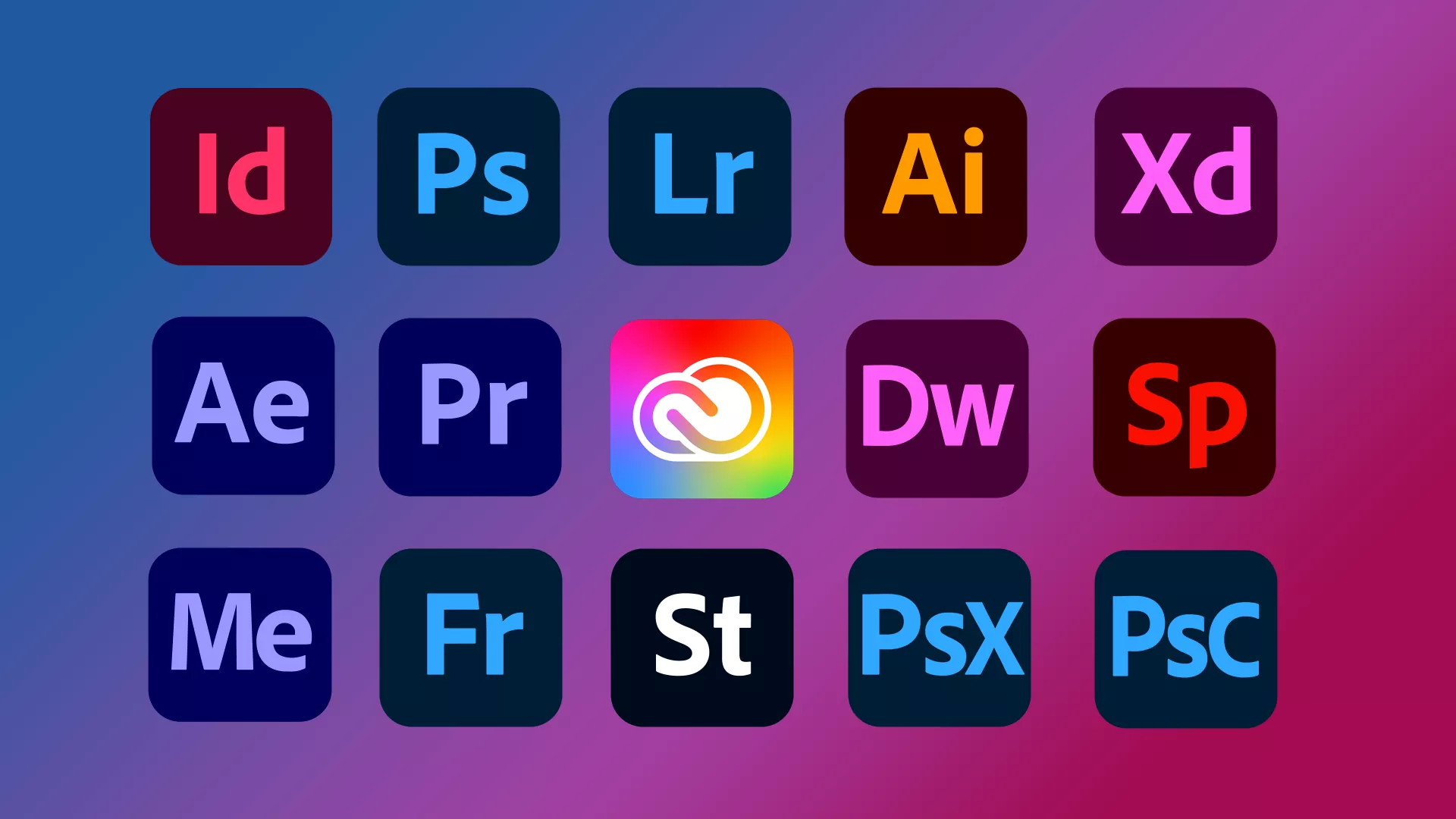
Adobe Creative Cloud is a subscription-based software service offered by Adobe Inc.
It gives users access to a collection of software used for graphic design, video editing, web development, photography, and cloud services.
Instead of purchasing and installing individual Adobe software products, users can subscribe to Creative Cloud and download the latest versions of Adobe applications to their computer or mobile device.
Adobe Creative Cloud is popular among professionals and creative enthusiasts because it ensures they always have access to the latest versions of Adobe software, along with regular updates and new features, without having to repurchase or reinstall software individually.
The subscription model also offers flexibility, as users can choose different plans based on their needs and budget.
#1 — Introduction to Adobe applications
Although Adobe Premiere Pro is aimed at video editing, you can use other applications within Adobe Creative Cloud to enhance your creative experience.
Here is a list of other commonly used Adobe applications.
- Adobe Photoshop: A powerful image editing software widely used by photographers and graphic designers.
- Adobe Illustrator: A vector graphics editor used for creating illustrations, logos, and other types of artwork.
- Adobe InDesign: A desktop publishing software used for creating documents, brochures, and magazines.
- Adobe After Effects: A digital motion graphics and visual effects software used in video and film production.
- Adobe Lightroom: A photo editing and organising software tailored for photographers.
- Adobe XD: A user experience and user interface design tool for creating interactive prototypes and designs for web and mobile applications.
- Adobe Acrobat Pro DC: A software for creating, editing, signing, and sharing PDF documents.
#2 — Which subscription plan is suitable for me?
Adobe splits their subscription plan into three types: Individual, Business and Student.
Look out for their differences below.
Individual Plan

The Individual Plan offers access to all Adobe applications and 100GB of individual cloud storage and is priced at S$70.37 per month.
Student Plan

Compared to the Individual Plan, the Student Plan gives the more value with the same benefits at only S$26.55 per month.
This makes it most suitable for students on a budget.
Business Plan
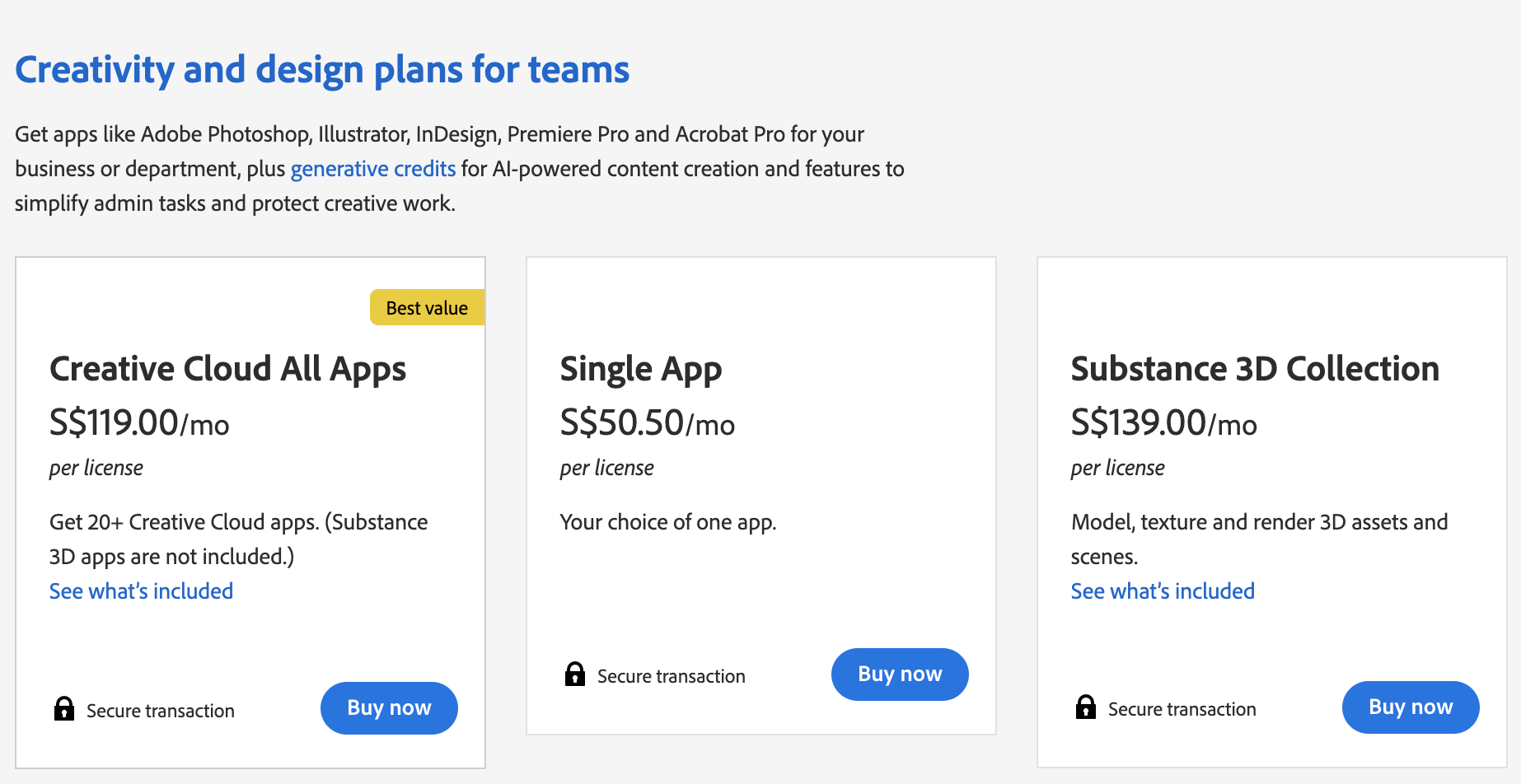
Out of the three available plan, the Business Plan gives larger access to other benefits, such as 1TB of cloud storage, a 180 day version history.
It is priced higher at S$119.00 per month, and is most suitable for firms looking to subscribe to Adobe Creative Cloud for their employees.
Adobe Premiere Pro System Requirements
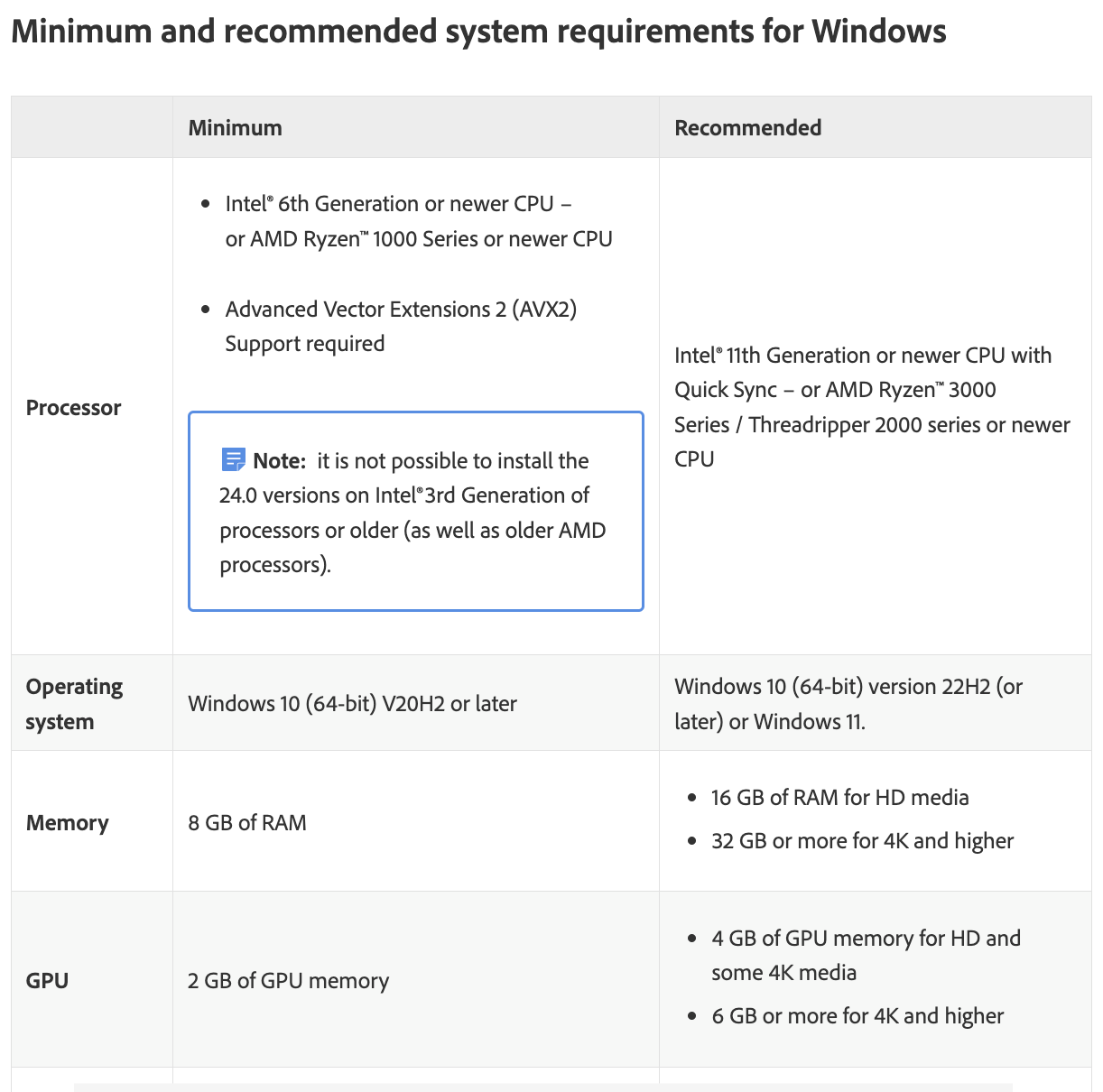
Coming back to Adobe Premiere Pro, video editing is known to be more taxing on the computer system as compared to web browsing.
If possible, check on the specifications of your computer’s Central Processing Unit (CPU), Graphic Processing Unit (GPU) and memory stick.
It is crucial to ensure that you meet the minimum requirements before purchasing any editing software.
Check if you meet the system requirements below.
#1 — Minimun requirments
CPU: Intel® 6th Generation or newer CPU – or AMD Ryzen™ 1000 Series or newer
GPU: 2 GB of GPU memory
Memory: 8 GB of RAM
Your computer should hit the above specifications in order to run the Adobe Premiere Pro application.
Although Premiere Pro should run on this specifications, there will be some performance trade-offs due to the age of the hardware above.
#2 — Recommended requirements
CPU: Intel® 11th Generation or newer CPU with Quick Sync – or AMD Ryzen™ 3000 Series / Threadripper 2000 series or newer CPU
GPU: 4 GB of GPU memory for HD, 6 GB or more for 4K and higher
Memory: 16 GB of RAM for HD media, 32 GB or more for 4K and higher
At the specifications above, your computer should be able to run the Adobe Premiere Pro application smoothly.
We recommend the latest Intel Core i7 Processor 13700 and an RTX 4070 12GB card for the best performance possible.
Check out the prices for these PC parts here.
#3 — What impact does VRAM have on Adobe Premiere Pro?
Having a GPU with ample Video Random-access Memory (VRAM) in video editing, like Adobe Premiere Pro, ensures smooth playback and real-time rendering of high-resolution videos.
It allows seamless application of effects, transitions, and colour grading. VRAM handles large data loads, especially in tasks involving 4K or higher-resolution footage, multiple streams, and VR/360° editing.
The GPU’s processing power combined with sufficient VRAM is vital for handling complex calculations and future software updates, ensuring efficient video editing workflows.
Premiere Pro 2023 New Features
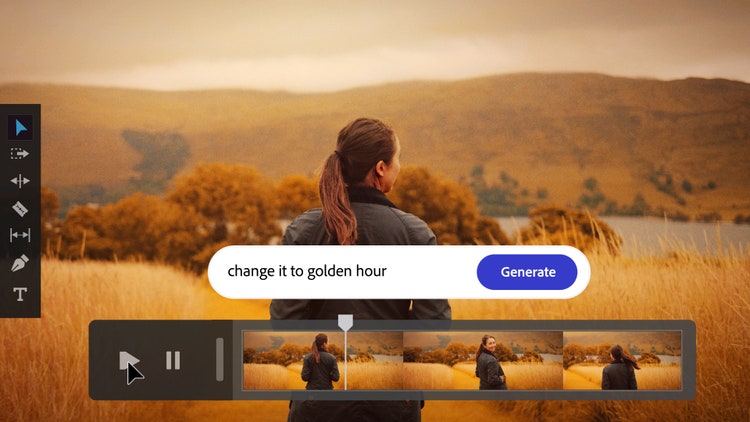
Adobe Premiere Pro’s new AI Generative Fill feature, powered by Adobe Firefly, automates various tasks in video editing.
It can create storyboards and pre- visualisations from user-provided scripts, expediting scene planning.
The update includes Text-based Editing, enabling natural language searches within raw footage, simplifying clip selection.
Additionally, an AI tool allows users to adjust colour and contrast through verbal commands, streamlining post-production processes.
The software also generates royalty-free sounds, music, subtitles, and logos automatically.
These enhancements significantly reduce manual work, enhancing efficiency in film production.
Adobe plans to integrate generative AI across its creative tools, revolutionising workflows in Premiere Pro and other applications.
Adobe Premiere Pro Tutorials
Learn Adobe Premiere Pro in 2023
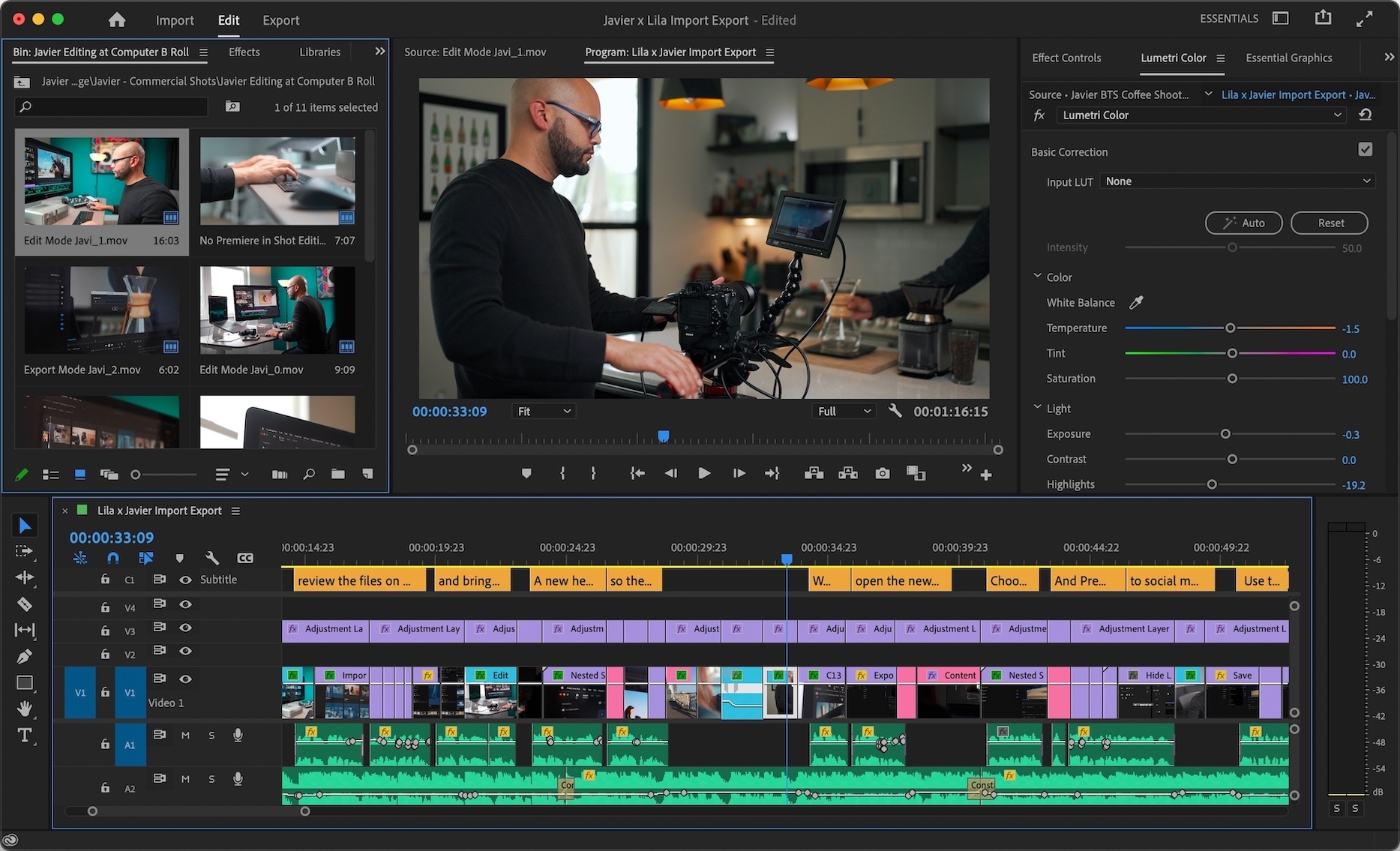
#1 — Premiere Pro Flowchart
2We have come up with a short flowchart for you to start editing in Adobe Premiere Pro.
Check it out below!
1) Create New Project
To start in Premiere Pro, click “File,” select “New,” then “Project.”
Name your project and set your desired settings before clicking “OK” to create a new project.
2) Import Footage
Import your media by right-clicking in the Project Panel, selecting “Import,” and navigating to your files.
Choose the files you want to import and click “Import” to add them to your project.
3)Create New Sequence
Right-click on your imported footage in the Project Panel, select “New Sequence From Clip,” or manually create a new sequence by clicking “File,” then “New,” and selecting “Sequence.”
Adjust the sequence settings as needed.
4) Trimming with Split and Cut Tool
Use the “Razor” (C) tool to split clips and the “Selection” (V) tool to cut and delete unwanted parts.
Select a clip, position the playhead, and press “C” to split, or use “V” to cut and remove sections.
5) Adding Effects
Drag effects from the Effects Panel onto your clips in the Timeline to apply them.
Customize the effect settings in the Effect Controls Panel to achieve the desired look or behavior.
6) Adding Transitions
Access the Effects Panel, search for transitions, and drag the chosen transition between two clips in the Timeline.
Adjust the transition duration in the Effect Controls Panel for seamless blending.
7) Colour Grading
Click on “Window” and select “Lumetri Color” to open the color grading panel.
Adjust exposure, contrast, saturation, and other parameters to enhance your footage.
Experiment with different color grading effects until you achieve the desired look.
8) Export
Once you’ve edited your video, click “File,” select “Export,” then “Media.”
Choose the export settings such as format, codec, and resolution.
Click “Export” to render your final video for sharing or distribution.
#2 — Where can I find tutorials?
Numerous online resources provide comprehensive tutorials to master Adobe Premiere Pro.
Platforms like YouTube host channels dedicated to video editing, offering step-by-step guides for beginners and advanced users.
Websites like LinkedIn Learning and Udemy offer structured courses taught by industry professionals, covering everything from basic tools to advanced techniques.
Adobe’s official website provides extensive documentation, tutorials, and forums, ensuring users have access to official guidelines and expert advice.
Additionally, communities like Reddit’s r/premiere and creative forums like Creative COW enable users to ask questions, share knowledge, and troubleshoot with experienced editors.
These diverse online resources cater to various learning preferences, making it convenient for aspiring editors to enhance their skills at their own pace.
We recommend you check out the tutorial guide here.
Alternatives to Premiere Pro
If you feel that Adobe Premiere Pro is unsuitable for you, don’t worry!
There is a plethora of other video editing software that you can consider below.
Final Cut Pro X (macOS):
Final Cut Pro X is a professional video editing software developed by Apple for macOS users.
It offers advanced editing features, high-quality effects, and seamless integration with other Apple software and hardware.
DaVinci Resolve (Windows, macOS, Linux):
DaVinci Resolve by Blackmagic Design is a powerful video editing and color grading software.
It provides professional-grade editing tools, advanced color correction, visual effects, and audio post-production capabilities, all in one application.
Avid Media Composer (Windows, macOS):
Avid Media Composer is a widely used professional video editing software in the film and television industry.
It offers robust editing tools, collaborative workflows, and advanced features suitable for large-scale productions.
HitFilm Express (Windows, macOS):
HitFilm Express is a free video editing and visual effects software.
It combines video editing tools with advanced visual effects compositing, making it an excellent choice for indie filmmakers and YouTubers looking for a powerful yet affordable solution.
CapCut (iOS, Android):
CapCut is a user-friendly mobile video editing app available on iOS and Android platforms.
It offers a range of basic editing tools, effects, transitions, and templates, making it suitable for quick and easy video editing directly from your mobile device.
Conclusion
Video editing is vital in today’s digital landscape, enabling diverse applications across industries.
It powers content creation for social media, marketing, and online education, enhancing engagement and learning experiences.
Overall, video editing is essential for effective communication, marketing strategies, education, entertainment, and creative expression, shaping how stories are shared and messages resonate in our interconnected world.
You can also contact us via the chatbot or simply drop us a DM on our Instagram page if you’d like to know more about our course – Mobile Videography and Video Editing.
. . . . .
